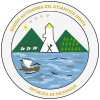This article includes a list of general references, but it lacks sufficient corresponding inline citations. (June 2020) |
North Caribbean Coast Autonomous Region
Región Autónoma de la Costa Caribe Norte (Spanish) | |
|---|---|
 Location of the North Caribbean Autonomous Region in Nicaragua. | |
| Coordinates: 14°01′41″N 83°22′51″W / 14.02806°N 83.38083°W | |
| Country | Nicaragua |
| Capital | Puerto Cabezas |
| Largest city | Puerto Cabezas |
| Seat | Puerto Cabezas |
| Municipalities | |
| Government | |
| • Type | Devolved government under presidential republic |
| • Body | Regional Council |
| • Regional Coordinator (Governor) | TBDL leader (FSLN) |
| Population (2021 estimate)[1] | |
| • Total | 541,189 |
| GDP (Nominal, 2015 US dollar) | |
| • Total | $600 million (2023)[2] |
| • Per capita | $1,000 (2023) |
| GDP (PPP, 2015 int. dollar) | |
| • Total | $1.6 billion (2023) |
| • Per capita | $2,700 (2023) |
| Regional Council | 47 councilors |
| National Assembly | 2 deputies (of 92)[citation needed] |
The North Caribbean Coast Autonomous Region[a] is one of two autonomous regions in Nicaragua. It was created along with the South Caribbean Coast Autonomous Region by the Autonomy Statute of 7 September 1987 through a division of the former Zelaya Department. It covers an area of 33,106 km2 and has a population of 541,189 (2021 estimate). It is the largest autonomous region or department in Nicaragua. The capital is Puerto Cabezas. It contains part of the region known as the Mosquito Coast.
The North Autonomous Caribbean Coast has a Regional Council of representatives of different political parties, such as the Sandinistas (FSLN) and YATAMA (ethnic indigenous party), as well as all the municipalities. They hold sessions in an Assembly in Puerto Cabezas.
The North Autonomous Caribbean Coast, in addition to Mestizos, contains populations from different indigenous groups, including the Miskitos, Mayangnas, and others. Regional official languages are Creole (Miskito Coast Creole and Rama Cay Creole), Miskito, Sumo (Mayangna and Ulwa), Garifuna, and Rama, in addition to the national official language of Spanish, most males in Puerto Cabezas speak some English from when it was a US fruit plantation.
- ^ Anuario Estadístico 2022. Instituto Nacional de Información de Desarrollo (INIDE)
- ^ "TelluBase—Nicaragua Fact Sheet (Tellusant Public Service Series)" (PDF). Retrieved 11 January 2024.
Cite error: There are <ref group=lower-alpha> tags or {{efn}} templates on this page, but the references will not show without a {{reflist|group=lower-alpha}} template or {{notelist}} template (see the help page).

